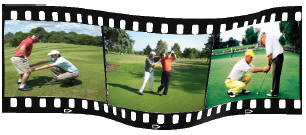What The Public Should Expect From Golf Lessons
 Peter Kessler, former Golf Channel personality and now the host of his own program on XM satellite radio, said that he believed the optimal length for a golf lesson was 10 minutes. He said this because there was time to give the student only one thing to work on, and that any more might be overkill.
Peter Kessler, former Golf Channel personality and now the host of his own program on XM satellite radio, said that he believed the optimal length for a golf lesson was 10 minutes. He said this because there was time to give the student only one thing to work on, and that any more might be overkill.
While Kessler is not a golf professional, he has a valid point. One of the worst things we can do as golf teachers is to pass out too much information. A common refrain that new teachers hear from their students is, “I have so much to remember.” Hopefully, as time goes on, this teacher realizes that when he or she hears this phrase, the student has been given too much information.
A trend in modern teaching is the use of high-tech video and training aids. Use of these items can be of great benefit to some students. The one drawback to training aids, specifically, is that the student is not likely to have such a training aid to use in between lessons. If a lesson is based solely upon the use of a particular training aid that the student does not possess, such a lesson may not be of much use. Training aids should be used only to supplement the lesson, and not be the sole focus of the lesson.
Of more use potentially to a student are drills, since they can be done without the presence of a teacher. Drills should be pertinent to the student’s problem, and they should be of such a nature that the student can easily do the drill. In other words, a student is likely to not do a drill correctly on his own that is complicated to execute or to set up.
Are there times that complicated drills, “excessive” instruction, or training aids that the student does not
possess should be used? Yes, but these times are not common. Usually, these types of lessons should be reserved for those in the low single-digit handicap range. These better players will likely have the ability to process several things at once, be able to remember how to set up and execute a complicated drill, and remember the feel of a training aid.
However, since the vast majority of our students do not fit this mold, we should return to very basic teaching for most of them. They simply do not have the capability to think about more than one swing change at a time. At the most, they might be able to think about one thing on the backswing and one thing either in the transition move or downswing.
A “problem” not necessarily exclusive to new teachers is the giving of information that seems too simple. Such teachers might shy away from giving a student something very simple because they feel that the student deserves more “expert” advice. There is some validity to this, because a student receiving such simple instruction might question the instruction’s very simplicity. For example, a veteran USGTF teacher tells of a student who kept popping up the driver. The teacher saw that the student’s swing was somewhat sound and that there was no reason the swing itself should be making the ball pop up.
However, the teacher did note that the student teed the ball too high (this was back in the days of persimmon drivers); thus, the student often only hit the bottom half of the ball with the clubface. The teacher advised the student to tee the ball lower, which the student did. After a couple of well-struck drives, the student said, “It can’t be that simple,” and asked for more instruction to “fix” the problem.
The teacher stuck to his guns and eventually convinced the student that the correct, albeit extremely simple, instruction was given. Fortunately, most students won’t complain about instruction that is seemingly too simple if it truly works.
Kessler’s 10-minute idea has merit. Challenge yourself to see if you can’t find and solve a problem within this time frame. If you can, it doesn’t mean the rest of the lesson time is unnecessary. Use it to reinforce the good behavior, and, like all good salesman, be sure to obtain a commitment for the next lesson.




